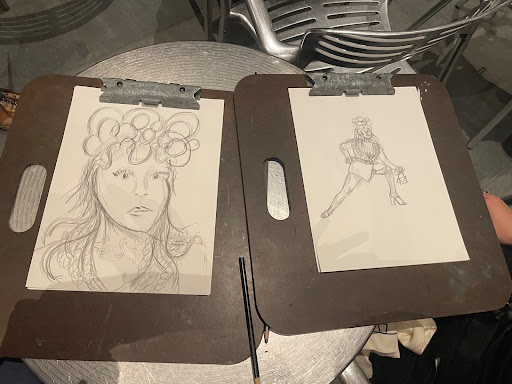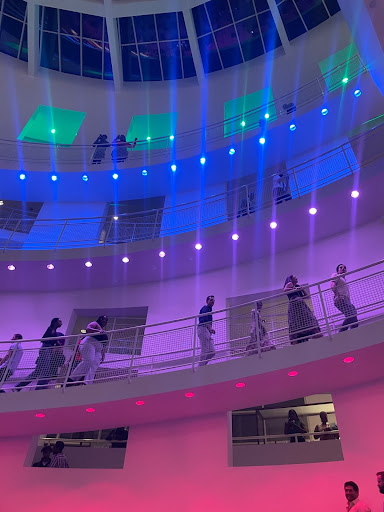We don’t always see spaces made for the celebration of the LGBTQ community’s joy, talent and connection — especially in major cultural institutions. Even originally safe or revolutionary spaces have changed rapidly over time, like gay bars or pride parades co-opted by non-queer people. And, while art museums have not historically been the most queer-friendly spaces, the High Museum’s Oct. 7 High Frequency Friday: Atlanta Pride Edition was an example of one way to create that space for joy.
The High Museum hosts a High Frequency Friday event on the first Friday of every month, often centered around music, art-making, dancing and tours in the galleries, all after closing hours. These events introduce an entirely new atmosphere to the typical quiet white-walled environment of the High’s galleries. While that atmosphere may be conducive to detailed art-viewing, for some visitors, a more communal, colorful and talkative museum experience, with a soundtrack, might prompt a more productive and enjoyable visit to the High. I love both atmospheres, but after a week of midterms, the latter was much needed.
The night began with docent-led tours in the contemporary art galleries. These were kept short and sweet, as our tour guide, Ron Richardson, ended by saying, “I’m sure you all want to go dance now!” The tour itself was not as participatory as I like my museum tours to be, but due to the large size of our group, it is understandable why he did not opt for this approach. In terms of content, the tour covered a beautiful, diverse and vibrant range of famous contemporary artists in the High Museum’s collection. Richardson began with a painting by Kehinde Wiley, known for his stunningly naturalistic portraits of Black subjects around the world, including former President Barack Obama. Wiley, along with artists like Robert Rauschenberg and Julie Mehretu, are icons of modern and contemporary art who I learned were LGBTQ-identified in this enlightening tour.

Tour participants in front of Julie Mehretu’s “Mogamma (A Painting in Four Parts): Part 2” (Zimra Chickering/The Emory Wheel)
As the tour wrapped up and the sun set, the dance floor began to fill in the Robinson Atrium. In the atrium, Ree de la Vega of A/V Radio was hosting and DJing for the entire evening, creating a colorful soundtrack that brought a celebration to the dance floor. The main complaint I have heard about previous High Frequency Fridays was that nobody was really dancing, so I have to give full credit to DJ Vega for getting hundreds of people on the dance floor, vibing and sweating to the tunes of iconic queer anthems like a remix of Whitney Houston’s “It’s Not Right but It’s Okay.”
Whenever the music and dancing got a bit overwhelming for the senses, visitors were given the option to participate in another equally enjoyable, more relaxing activity. Out on the Orkin Terrace, JayBella, a Georgian drag queen, model and public figure, posed for a portrait drawing session. Adorned with a green suit-dress, shiny dollar-sign necklace and curly locks of golden hair, JayBella posed with elite skill. Accompanied by drawing tips from some High Museum staff members, this activity felt like an integral part of the evening, creating a well-balanced night.

Sketches by Zimra Chickering (24C) and Madison Lee (24C).
Back in the Robinson Atrium, there were additional performances happening at one-hour intervals. The three performers were drag king and self-proclaimed “Ghost with the Most” Jarvis Hammer, the Wussy Mag culture editor Ivana Fischer and Canzara Szn, drag queen and Emory HIV researcher. The amount of sheer talent strutting down the atrium’s ramps was undeniable, with each performer capturing the audience through their ornate costumes, impeccable performance presence and skilled lip sync or dance moves.
The timing between performances was perfect, allowing people to dance, meet fellow queer folk or draw and grab a drink on the terrace. It was also wonderful that the activities took place throughout the evening from 6:00 p.m. to 10:00 p.m. because “queer time” exists, and there was no way hundreds of LGBTQ people were getting to one location at a specific, linearly structured time. Instead, people popped in and out of the museum, with many more entering even as I was leaving.
While the vibes and the programming were immaculate, the event was far less accessible than it could have been. These events are free with museum membership, but for those who cannot afford such a membership, the ticket price is $25, plus $18 to park in their garage and extra if you wanted to enjoy drinks and food at the event.
Considering this was an event marketed to the Atlanta queer community, it was a big misstep to create a financial barrier for participating, as the LGBTQ community and communities of color are far more susceptible to socioeconomic disadvantages stemming from social discrimination. I understand that museums have to be profit-focused to keep their lights on and doors open, but there are ways to make money that do not profit off of the work of LGBTQ folks and BIPOC members of the community.

Robinson Atrium during the High Frequency Friday: Atlanta Pride Edition (Zimra Chickering/The Emory Wheel)
Despite those challenges, the High Museum’s Atlanta Pride Edition of their usual High Frequency Fridays was a beautiful space for LGBTQ joy and community, leaving space for each and every visitor to be an art history nerd, a danceaholic, an artist, a performer, a singer, a new friendly face and a fashion icon in their own right. I only hope to see this same commitment to marginalized community engagement in the museum space extended throughout the year and across communities, not just during Atlanta Pride weekend and not just for the LGBTQ community.
Zimra Chickering (24C) is a born and raised Chicagoan who studies art history and nutrition science. She is also a student docent for the Michael C. Carlos Museum, Woodruff JEDI Fellow, educational committee chair for Slow Food Emory, and Xocolatl: Small Batch Chocolate employee. Zimra loves cooking, visiting art museums, photography, doing Muay Thai, drinking coffee, and grocery shopping. She uses writing as an outlet to reflect upon issues and oppurtunities within artistic institutions, and the unique ways in which food and art can act as communicators of culture.





